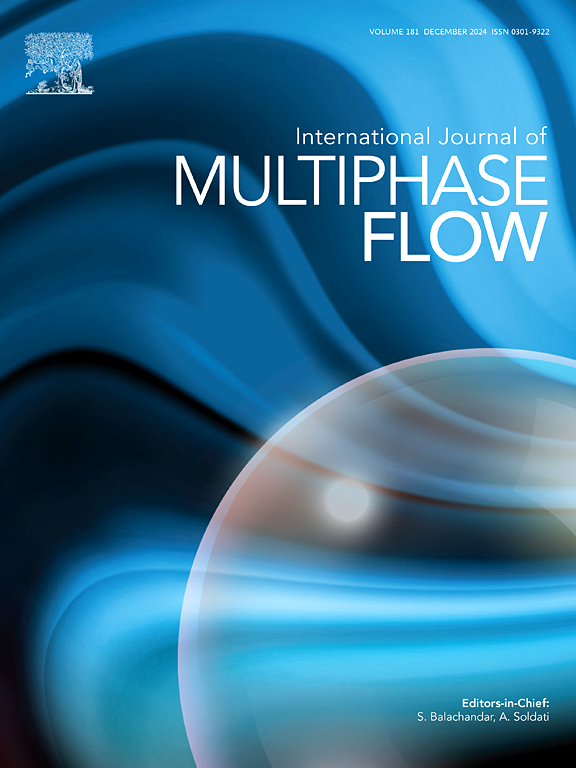近耦合气体雾化中一次分裂的实验研究
IF 3.6
2区 工程技术
Q1 MECHANICS
International Journal of Multiphase Flow
Pub Date : 2024-09-28
DOI:10.1016/j.ijmultiphaseflow.2024.105009
引用次数: 0
摘要
使用数字内联全息技术研究了近耦合气体雾化(CCGA)中液态水射流的一次破裂。使用的喷嘴具有恒定的液体突起长度,并具有三个不同的顶角(θ = 14o、24o 和 34o)。测量在两个韦伯数(Weg = 57.5 和 82.5)下进行。在每个韦伯数下,研究了五种不同的动量通量比 M。对瞬时液体射流界面的详细分析表明,随着 θ 的增大,"拍摄 "发生在临界 M 较低的位置。此外,随着 M 的增加,界面长度的峰值概率向更大值移动,而 θ 的增加则导致最大长度增加。分形尺寸随下游距离的增加而增加。基于面积的液滴直径分布的尺寸范围很广,最大可达 3 毫米,并用最小二乘法拟合的幂律(包括指数截止值)进行了很好的描述。在 θ = 24o,M = 1.67 和 2.40,Weg = 57.5 和 82.5 时产生的液滴数量最多。圆形液滴的百分比(基于圆度阈值)在 θ = 14o 时最高,并随着 M 的增大而降低。本文章由计算机程序翻译,如有差异,请以英文原文为准。

Experimental investigation of primary breakup in close-coupled gas atomization
Primary breakup of a liquid water jet in close-coupled gas atomization (CCGA) was studied using digital inline holography. Different nozzles with constant liquid protrusion length and characterized by three different apex angles, = 14, 24 and 34 were used. Measurements were conducted at two Weber numbers, We = 57.5 and 82.5. At each We, five different momentum flux ratios, , were studied. A detailed analysis of the instantaneous liquid jet interfaces indicated that the “filming” occurred at a lower critical with increasing . Furthermore, with increasing , peak probabilities of interface lengths shifted to larger values while increasing led to increased maximum lengths. Fractal dimensions increased with downstream distance. Distributions of area-based droplet diameters spanned a broad size range up to 3 mm and were well described by least-squares fitted power laws, including an exponential cut-off. The highest number of droplets was generated at = 24 for = 1.67 and 2.40 for We = 57.5 and 82.5, respectively. The percentage of circular droplets (based on a circularity-based threshold) was highest at = 14 and decreased with increasing .
求助全文
通过发布文献求助,成功后即可免费获取论文全文。
去求助
来源期刊
CiteScore
7.30
自引率
10.50%
发文量
244
审稿时长
4 months
期刊介绍:
The International Journal of Multiphase Flow publishes analytical, numerical and experimental articles of lasting interest. The scope of the journal includes all aspects of mass, momentum and energy exchange phenomena among different phases such as occur in disperse flows, gas–liquid and liquid–liquid flows, flows in porous media, boiling, granular flows and others.
The journal publishes full papers, brief communications and conference announcements.

 求助内容:
求助内容: 应助结果提醒方式:
应助结果提醒方式:


